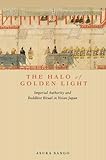The Halo of Golden Light : Imperial Authority and Buddhist Ritual in Heian Japan / Asuka Sango.
Material type: TextPublisher: Honolulu : University of Hawaii Press, [2015]Copyright date: ©2015Description: 1 online resource (304 p.) : 4 b&w illustrationsContent type:
TextPublisher: Honolulu : University of Hawaii Press, [2015]Copyright date: ©2015Description: 1 online resource (304 p.) : 4 b&w illustrationsContent type: - 9780824839864
- 9780824854003
- 294.3095209021 23
- online - DeGruyter
- Issued also in print.
| Item type | Current library | Call number | URL | Status | Notes | Barcode | |
|---|---|---|---|---|---|---|---|
 eBook
eBook
|
Biblioteca "Angelicum" Pont. Univ. S.Tommaso d'Aquino Nuvola online | online - DeGruyter (Browse shelf(Opens below)) | Online access | Not for loan (Accesso limitato) | Accesso per gli utenti autorizzati / Access for authorized users | (dgr)9780824854003 |
Browsing Biblioteca "Angelicum" Pont. Univ. S.Tommaso d'Aquino shelves, Shelving location: Nuvola online Close shelf browser (Hides shelf browser)

|

|

|

|

|

|

|
||
| online - DeGruyter Romancing Human Rights : Gender, Intimacy, and Power between Burma and the West / | online - DeGruyter Hokusai’s Great Wave : Biography of a Global Icon / | online - DeGruyter Tea in China : A Religious and Cultural History / | online - DeGruyter The Halo of Golden Light : Imperial Authority and Buddhist Ritual in Heian Japan / | online - DeGruyter Fragrant Orchid : The Story of My Early Life / | online - DeGruyter From King Cane to the Last Sugar Mill : Agricultural Technology and the Making of Hawaii's Premier Crop / | online - DeGruyter Marathon Japan : Distance Racing and Civic Culture / |
Frontmatter -- Contents -- Acknowledgments -- Introduction -- One. The Emperor and the Golden Light Sūtra -- Two. Buddhist Debate and the Religious Policy of the Heian State -- Three. Clerical Promotion -- Four. Buddhist Rituals and the Reconstitution of the Ritsuryō Polity -- Five. When Rites Go Wrong -- Six. Ritual Imitation and the Retired Emperor -- Conclusion: The Halo of Perpetuity -- Appendix: Jun Misai- E Rites (909- 1185) -- Notes -- Character Glossary -- Bibliography -- Index -- ABOUT THE AUTHOR
restricted access online access with authorization star
http://purl.org/coar/access_right/c_16ec
In this pioneering study of the shifting status of the emperor within court society and the relationship between the state and the Buddhist community during the Heian period (794-1185), Asuka Sango details the complex ways in which the emperor and other elite ruling groups employed Buddhist ritual to legitimate their authority. Although considered a descendant of the sun goddess, Amaterasu, the emperor used Buddhist idiom, particularly the ideal king as depicted in the Golden Light Sūtra, to express his right to rule. Sango's book is the first to focus on the ideals presented in the sūtra to demonstrate how the ritual enactment of imperial authority was essential to justifying political power. These ideals became the basis of a number of court-sponsored rituals, the most important of which was the emperor's Misai-e Assembly. Sango deftly traces the changes in the assembly's format and status throughout the era and the significant shifts in the Japanese polity that mirrored them. In illuminating the details of these changes, she challenges dominant scholarly models that presume the gradual decline of the political and liturgical influence of the emperor over the course of the era. She also compels a reconsideration of Buddhism during the Heian as "state Buddhism" by showing that monks intervened in creating the state's policy toward the religion to their own advantage. Her analysis further challenges the common view that Buddhism of the time was characterized by the growth of private esoteric rites at the expense of exoteric doctrinal learning.The Halo of Golden Light draws on a wide range of primary sources-from official annals and diaries written by courtiers and monks to ecclesiastical records and Buddhist texts-many of them translated or analyzed for the first time in English. In so doing, the work brings to the surface surprising facets in the negotiations between religious ideas and practices and the Buddhist community and the state.
Issued also in print.
Mode of access: Internet via World Wide Web.
In English.
Description based on online resource; title from PDF title page (publisher's Web site, viewed 02. Mrz 2022)


